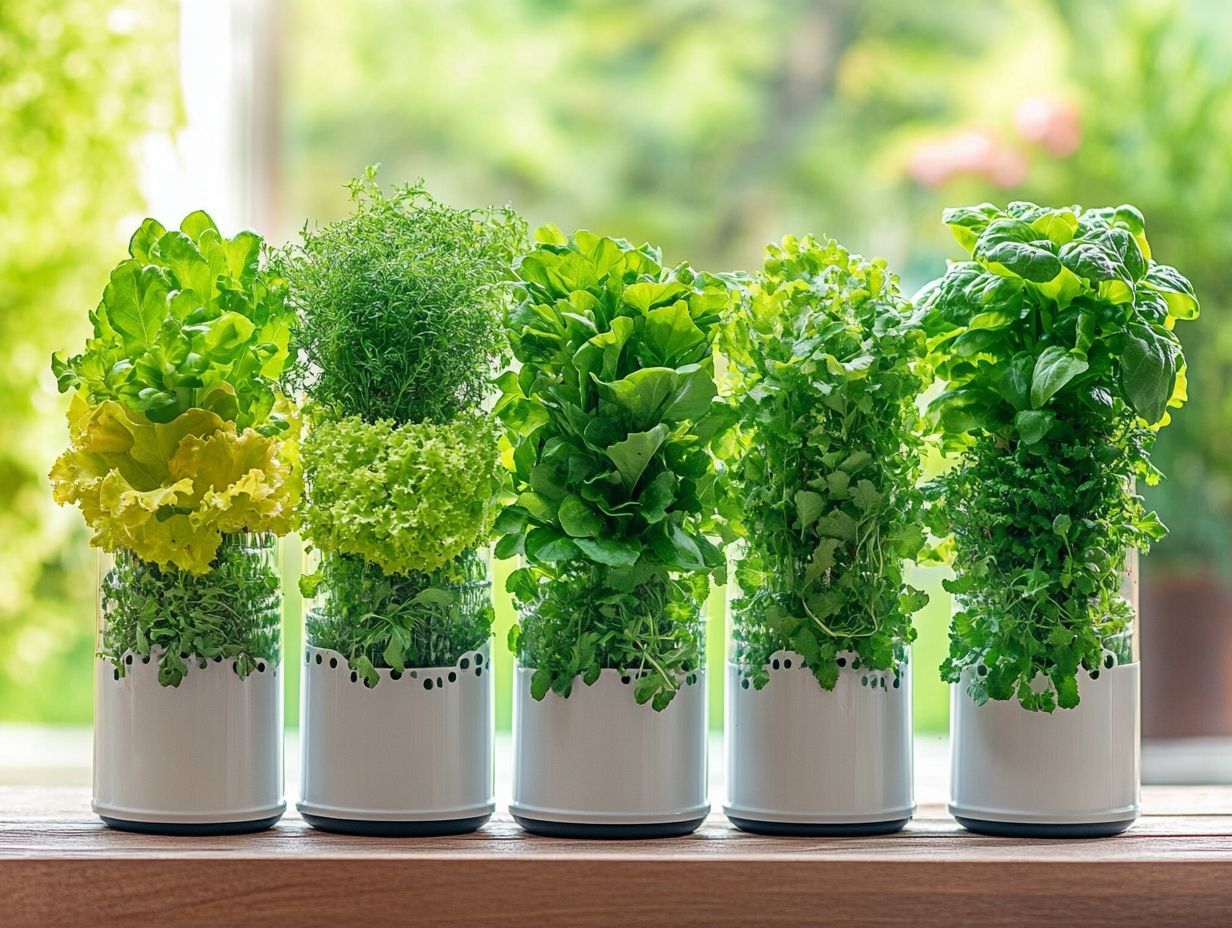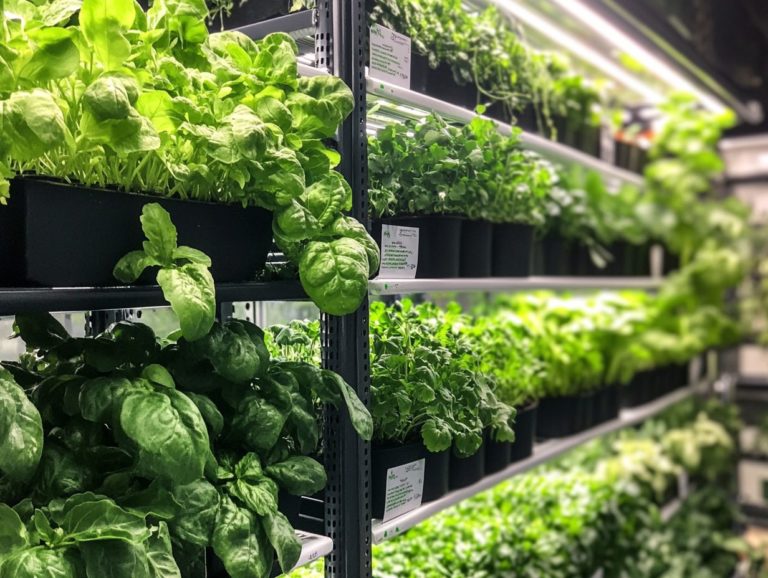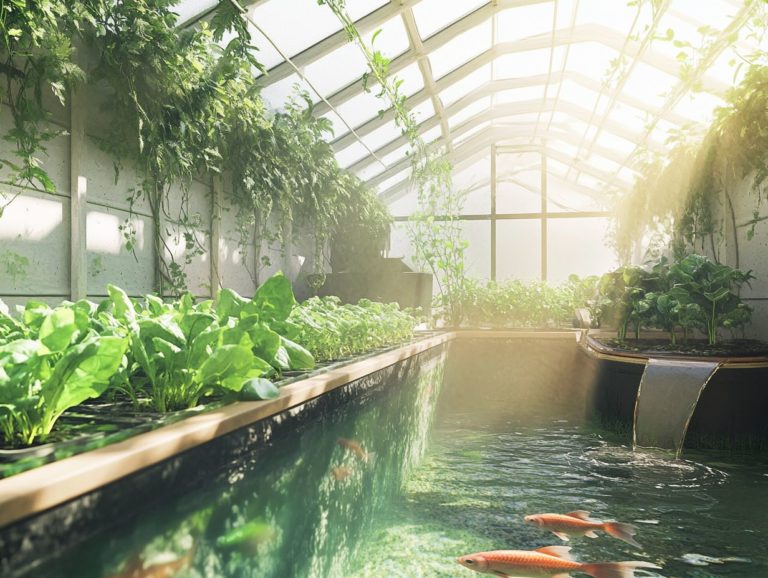5 Unique Hydroponic Systems to Try This Year
As interest in sustainable gardening continues to rise, hydroponics emerges as a sophisticated method for cultivating plants without the need for soil.
This article delves into five distinct hydroponic systems, each offering its own unique benefits and characteristics suited for both novice and seasoned gardeners.
You ll explore the fundamentals of hydroponics, uncover its advantages, and receive expert guidance on selecting and maintaining the ideal system tailored to your needs.
Plus, you ll discover valuable tips to steer clear of common pitfalls. Prepare to elevate your gardening experience to new heights!
Contents
- Key Takeaways:
- 1. Vertical Hydroponic System
- 2. Ebb and Flow Hydroponic System
- 3. Aeroponic System
- 4. Drip System
- 5. Deep Water Culture System
- What Is Hydroponics and How Does It Work for Indoor Gardening?
- What Are the Benefits of Using Hydroponic Systems?
- What Are the Different Types of Hydroponic Systems?
- How Can One Choose the Right Hydroponic System for Their Needs?
- What Are Some Tips for Setting Up and Maintaining a Hydroponic System?
- What Are Some Common Mistakes to Avoid When Using Hydroponic Systems?
- Frequently Asked Questions
- What Are Hydroponic Systems and Why Should I Try Them This Year?
- What Are the Benefits of Using Hydroponic Systems?
- What Are the 5 Unique Hydroponic Systems to Try This Year?
- What Is the Kratky Method and Why Is It Worth Trying?
- How Does the Ebb and Flow Hydroponic System Work?
- Which Hydroponic System Is Best for Growing Herbs and Leafy Greens?
Key Takeaways:

- Explore the world of hydroponics with these 5 unique systems, including vertical, ebb and flow, aeroponic, drip, and deep water culture.
- Hydroponic systems save space and produce higher yields.
- Consider your space, budget, and plant type when choosing a system.
1. Vertical Hydroponic System
Vertical hydroponic systems present an innovative solution that enables you to maximize your home garden space. You can grow vibrant herbs and fresh vegetables, even in small spaces.
These systems are designed with a compact footprint, making them ideal for urban environments. They promote sustainable farming practices and use significantly less water than traditional gardening methods, which is a game changer for conservation-minded individuals.
Imagine cultivating a diverse array of plant varieties, from leafy greens to strawberries and even small fruiting crops. Vertical gardens open the door to endless possibilities for fresh produce right at your fingertips.
With built-in grow stations, the gardening process becomes a breeze. They offer essential support for nutrient delivery and convenient lighting options. This means you can revel in the joys of home-grown food without grappling with the complexities of conventional gardening.
2. Ebb and Flow Hydroponic System
The ebb and flow hydroponic system is an incredibly efficient method that allows you to optimize water circulation and nutrient management, enabling your plants to flourish by delivering the essential nutrients they need for healthy growth.
This system works by periodically flooding the plant roots with nutrient-rich water from a reservoir, which is then drained away, giving the roots a chance to absorb the nutrients while also enjoying plenty of oxygen. This dynamic cycle enhances nutrient uptake and promotes vigorous root development.
You’ll likely find this methodology appealing for its ease of maintenance, as it significantly reduces the labor usually required for traditional farming, making it especially suited for organic growing.
By ensuring a balanced supply of nutrients, this efficient approach not only boosts plant health but also leads to higher yields, making it an enticing option for both novice and seasoned gardeners alike.
3. Aeroponic System
Aeroponic systems embody a modern method of hydroponics, where you can suspend plants in air and mist them with a nutrient-rich solution, creating optimal growth conditions. Utilizing grow lights enhances photosynthesis and elevates plant care to an art form.
You’ll love this innovative method because it offers incredible benefits! Its lightweight design allows for effortless installation in various settings, from urban rooftops to indoor gardens. Electric pumps play a vital role in delivering the nutrient solution efficiently, ensuring each plant receives the exact amounts needed for vigorous growth. For those interested in maximizing their herb garden, exploring the best hydroponic systems for herbs can provide valuable insights.
Maintaining proper light schedules is crucial, as it mimics the patterns of natural sunlight, fostering healthy photosynthesis. This comprehensive care not only amplifies plant yields but can also accelerate growth rates, making aeroponic systems an enticing choice for both hobbyists and commercial growers alike.
4. Drip System

The drip hydroponic system is an efficient method for delivering precise amounts of water and nutrients directly to the roots of your plants. Its compact design makes it ideal for both novice gardeners and seasoned growers.
This innovative approach employs a network of tubes and emitters. This ensures that water droplets reach each plant with pinpoint accuracy, conserving resources and minimizing waste. For those interested in scaling up their gardening efforts, check out the best hydroponic systems for large scale gardening to achieve optimal hydration and enhanced nutrient absorption that fuels vibrant plant growth.
One great benefit of this system is its adaptability. Whether you re growing towering tomatoes or delicate herbs, the drip system adjusts easily to accommodate different plant heights. The integration of seed pods simplifies the planting process, helping you maximize your yield potential and promoting robust root development.
5. Deep Water Culture System
Deep Water Culture (DWC) systems offer a straightforward yet powerful hydroponic approach by immersing plant roots in a nutrient-rich water reservoir. This method promotes rapid growth and yields high-quality plant varieties, while also encouraging eco-friendly gardening practices.
At the heart of this technique lies a few essential components, notably an air pump that supplies the oxygen vital for robust root development. In a DWC setup, managing nutrient solutions is key. Monitor pH and nutrient levels to ensure optimal plant health.
Lettuce, herbs, and strawberries thrive in this nutrient-rich environment, benefiting from a constant supply of essential elements. By adopting DWC, you open the door to faster growth rates and higher yields, making it an enticing option for sustainable farming, especially in limited spaces.
What Is Hydroponics and How Does It Work for Indoor Gardening?
Hydroponics presents an innovative way to grow plants without the fuss of soil. Instead, you ll use nutrient solutions liquid food for plants to provide essential nutrients, making indoor gardening possible in small spaces and accessible for beginner gardeners. Imagine cultivating a diverse range of plants, from microgreens to herbs, while effortlessly tracking their growth.
This method relies on water-rich solutions packed with vital nutrients, eliminating the need for soil as an anchor. With roots directly exposed to these nutrients, your plants can absorb what they need more efficiently, leading to faster growth rates and higher yields compared to traditional methods. Plus, the soilless nature of hydroponics minimizes the risks associated with pests and diseases commonly found in soil environments. To learn more about this innovative approach, check out hydroponic systems.
As a gardener, you’ll easily monitor nutrient levels and adjust conditions to promote optimal health. Hydroponics is well-suited for growing a wide variety of plants, from leafy greens to vibrant flowering fruits. For those with limited space, exploring the top hydroponic systems for small spaces allows you to cultivate your garden all within the comfort of your home.
What Are the Benefits of Using Hydroponic Systems?
Using hydroponic systems offers numerous benefits, from sustainable farming practices that bolster food security to efficient resource use. It s no wonder this method is a favorite among contemporary gardeners.
- Conserves water significantly using up to 90% less than traditional soil-based gardening.
- Promotes faster growth rates and higher yields, allowing for quicker harvests.
- Accessible hydroponic kits often come equipped with step-by-step instructions.
For optimal results, regularly monitor pH levels and ensure your plants receive adequate light exposure, as these elements are crucial to their development. By following these practical tips, even novice gardeners can cultivate vibrant, thriving gardens all year round.
What Are the Different Types of Hydroponic Systems?

There are various types of hydroponic systems, each boasting unique characteristics and advantages. It’s crucial for you, as a beginner gardener, to grasp these options so you can select the system that aligns perfectly with your needs and preferences, drawing insights from customer reviews and considering ease of use.
For example, vertical gardening systems maximize space by stacking plants, making them a fantastic choice for indoor gardens with vertical systems working with limited room. On the other hand, deep water culture hydroponic systems shine when it comes to fast-growing plants like tomatoes, basil, and other herbs like lettuce and microgreens. For those starting out, exploring the top hydroponic growing systems for beginners can provide valuable insights, as they offer a consistent, nutrient-rich water supply.
Drip irrigation systems offer versatility, accommodating a range of crops, including tomatoes and bell peppers, though they do demand more maintenance to avoid pesky clogs. By understanding these distinctions, you can make informed decisions that ensure your chosen method aligns with your home gardening ambitions and available resources.
How Can One Choose the Right Hydroponic System for Their Needs?
Choosing the right hydroponic system for your needs means thinking about factors like your available space in your home garden, budget, and the types of plants you want to grow. It s essential to select a user-friendly hydroponic system that matches your gardening goals while also being cost-effective.
Consider the dimensions and weight of the indoor grow stations for efficient use of space in the area you plan to use. Remember, some systems require more floor space and vertical height than others. Think about whether you want to grow leafy greens, fruiting plants such as tomatoes and peppers, or herbs like basil, parsley, and thyme for cooking, as different systems cater to various plant types and growth strategies. For those starting out, check out DIY hydroponic system plans for beginners to find the right fit for your needs.
Maintenance efforts are also crucial; some setups demand daily attention for maintenance and plant care, while others are designed to be more hands-off for beginner gardeners. To make a well-informed decision, compare several systems by researching their features, reading user reviews, and perhaps visiting local gardening centers to see them in action.
This practical approach will lead you to success in finding the best hydroponic solution and effective nutrient management for healthy plants tailored specifically to your gardening ambitions.
What Are Some Tips for Setting Up and Maintaining a Hydroponic System?
Setting up and maintaining your hydroponic system effectively requires keen attention to detail and proper water circulation along with some essential tips for effective garden maintenance practices. You’ll want to monitor nutrient management and ensure proper water circulation to promote healthy growth.
- Choosing the right location for your indoor garden is crucial; a space with adequate light, temperature control, and accessibility will significantly impact your success.
- Once you’ve selected the ideal spot, assemble your hydroponic system with care, ensuring that all components fit seamlessly and function correctly before introducing your plants.
- Consistency is key for maintaining optimal pH levels; maintaining optimal pH levels and temperature will create a stable environment for your plants.
Regularly check for any signs of pests, diseases, and nutrient solutions tailored for various plant varieties, and be ready to adjust your nutrient formulas and plant food as needed, tailoring them to the specific plants you’re growing. For a deeper understanding, look into the future of hydroponic growing systems. By staying proactive and attentive to these details, you can cultivate lush, thriving hydroponic gardens that flourish under your care.
Get started today and watch your indoor garden flourish!
What Are Some Common Mistakes to Avoid When Using Hydroponic Systems?
As a beginner gardener venturing into the world of Hydroponics for sustainable farming, you might face common mistakes, but don t worry! Here s how to avoid them.
You may mismanage nutrient solutions, neglect water levels, or fail to adjust your automated watering system. These mistakes can harm your plants’ growth and health.
To succeed in hydroponics, it’s vital to recognize and avoid these common pitfalls for beginner gardeners. For example, without the right balance of nutrients, your plants might suffer from deficiencies or toxicities that stunt their growth. Additionally, exploring hydroponic systems for home gardeners can provide valuable insights. Consistently monitoring water levels is equally important; fluctuations can lead to root rot and dehydration, both of which can compromise your plants’ vitality.
Understanding the specific needs of each crop is essential, as different varieties require unique adjustments in light schedules, nutrients, and watering systems. Dedicating yourself to thorough research and committing to ongoing education will offer you invaluable insights, enabling you to fine-tune your hydroponic systems for optimal growth and food security.
Frequently Asked Questions

What Are Hydroponic Systems and Why Should I Try Them This Year?
Hydroponic systems allow you to grow plants without soil by using a nutrient-rich solution instead. They are becoming increasingly popular due to their ability to grow plants faster and more efficiently. Trying them out this year can help you discover a new and innovative way to grow your own produce.
What Are the Benefits of Using Hydroponic Systems?
Hydroponic systems provide several benefits, including faster growth, higher yields, and the ability to grow plants in small spaces. They also use less water and are less prone to pest infestations, making them a more sustainable and eco-friendly choice.
What Are the 5 Unique Hydroponic Systems to Try This Year?
Some unique hydroponic systems to try this year include the Kratky method, deep water culture, ebb and flow, aeroponics, and drip irrigation. Each system offers its unique benefits and can be tailored to fit your specific growing needs.
What Is the Kratky Method and Why Is It Worth Trying?
The Kratky method is a passive hydroponic system that requires no electricity or pumps. It involves growing plants in a non-circulating nutrient solution, with the roots submerged in the solution. It is a low-cost and low-maintenance system that can be easily set up by beginners.
How Does the Ebb and Flow Hydroponic System Work?
The ebb and flow system, also known as flood and drain, involves flooding the plant’s roots with nutrient solution and then draining it back into a reservoir. This cycle is repeated several times a day, providing the plants with oxygen and nutrients while preventing waterlogging.
Which Hydroponic System Is Best for Growing Herbs and Leafy Greens?
Drip irrigation is considered one of the best hydroponic systems for growing herbs and leafy greens. This system involves a timer-controlled pump that drips nutrient solution onto the plants’ roots, providing a consistent supply of water and nutrients. It is also a popular choice for its simplicity and versatility.
Start your hydroponic journey today and enjoy fresh produce right at home!






